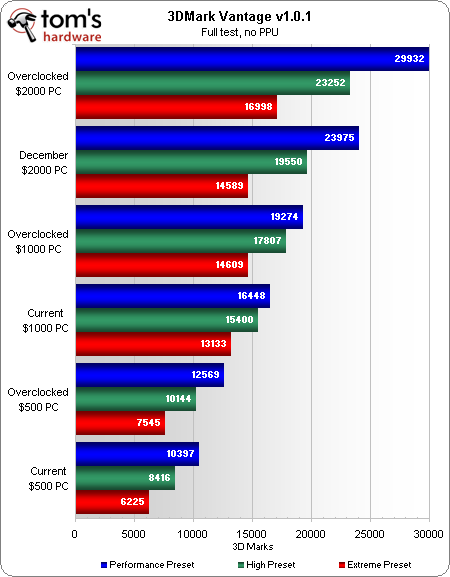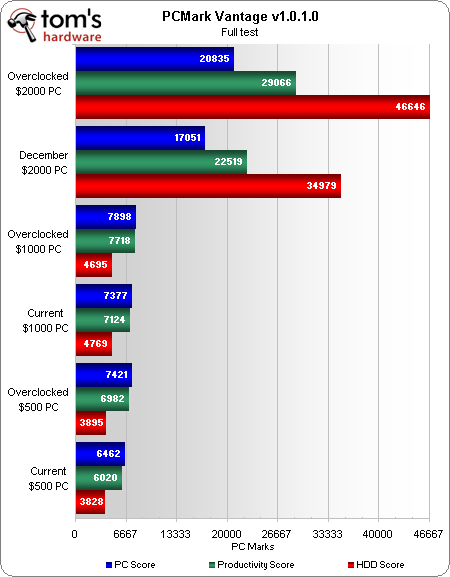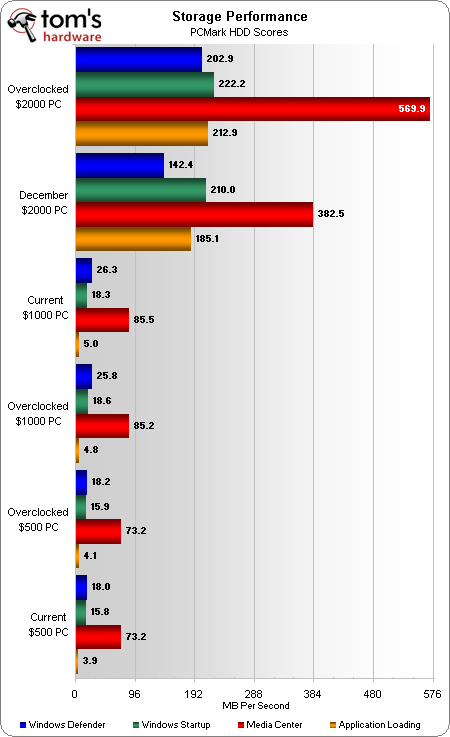System Builder Marathon, December 2010: Value, Compared
New benchmarks, new test methods, and new hardware mark exciting updates to this month’s System Builder Marathon. Today, we cover the most exciting part of all: the value competition. Remember, we're giving all three systems away, so enter to win them!
Benchmark Results: 3DMark And PCMark
Though games are typically bottlenecked at low resolutions by a CPU, 3DMark loves graphics power even at its 1280x1024 “Performance” preset. 3DMark also awards points for extra CPU cores, whereas few games can benefit from more than the three found in our $500 build.
The overclocked $1000 PC catches up to the stock $2000 configuration at 3DMark’s “Extreme” preset. If this happens in real games, the expensive build will surely have a value penalty.
PCMark loves fast drives, putting the $2000 PC’s striped SSD configuration far ahead of its lower-priced competitors. Let’s see how that plays out in a few individual performance scores.
While most file system benchmarks show transfer times, PCMark converts these into MB/s based on the total size of the files transferred. The results still include seek time, since it adds to the number of seconds in PCMark’s MB/s calculation. The results charted above are the only synthetic tests that will make it into our value analysis, since we have real applications to measure GPU and CPU performance.
Current page: Benchmark Results: 3DMark And PCMark
Prev Page Test Settings Next Page Benchmark Results: SiSoftware SandraGet Tom's Hardware's best news and in-depth reviews, straight to your inbox.
-
wribbs I really enjoy these SBM articles but you need to start putting out these systems/articles faster because by the time you post these configs no one would build them. These "December" systems all use November parts. When you know an important part (CPU/GPU) is going to be replaced by a newer model before the article will post, just wait a few days for it.Reply
That said, SSD is a great addition as well as some of the other difficult to measure in value parts. -
Your 'flexible' statistics are a joke! We'd really like the $2000 system to win to so we'll shovel in the hard drive figures with massive over-emphasis... It's bollocks.Reply
-
Twoboxer I don't understand introducing SSDs into these builds. Buying an SSD is a binary decision: if you want faster load times, you add an SSD . . . if not, you don't.Reply
These builds are targeted at a fixed budget, and (at the moment, with these budgets) money should never be spent on an SSD at the expense of more cpu or graphics power.
Dropping SSDs would also stop convoluting the "value" comparison. -
ethaniel 82% performance at half the cost? 500 USD build for me, thanks. I can add a 100 bucks SSD anytime (and they'll just keep dropping). Newegg has some nice, cheap SSDs out there...Reply -
tapher This has been a very informative triple build review, and this article sums up the lessons nicely! The point about the $1000 PC and games being fine with dual cores was gratifying to see echoed in the summation.Reply
The fact that problems were encountered during the builds, such as the issue with memory, and the issue with the bios; these are important practical lessons that make the articles well worth the time to read.
Overall, I can't imagine a better choice of builds, nor a better outcome, given Sandy Bridge on the horizon. -
jestersage How about timing the marathon differently. It seemas doing it at the end of the quarter isn't such a good idea because of new tech launch schedules this half of the year. Maybe release the article in the middle of every quarter?Reply
In any case, the $500 build rocks my boat. I just feel it isn't right to saddle the $1000 build with a dual core, hyper-threaded or not. An AMD triple/quad core with bad-@ss cooling (at the same price) might have been better. -
Crashman canting_dissentorYour 'flexible' statistics are a joke! We'd really like the $2000 system to win to so we'll shovel in the hard drive figures with massive over-emphasis... It's bollocks.d00d, that's what a bunch of readers wanted. We all know that SSDs waste money for most users, but the site was overwhelmed by readers who claimed they couldn't wait for four seconds on a process that should open in three.Reply




